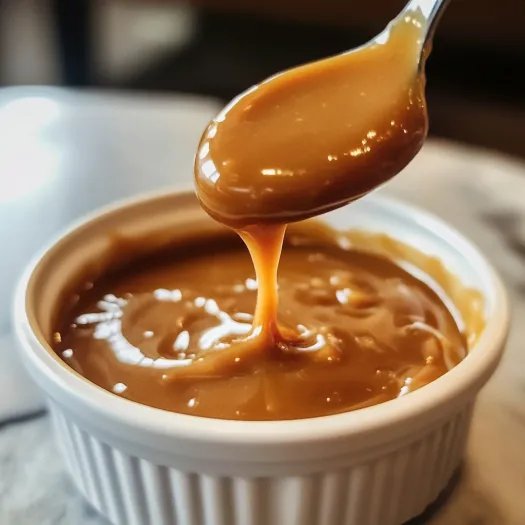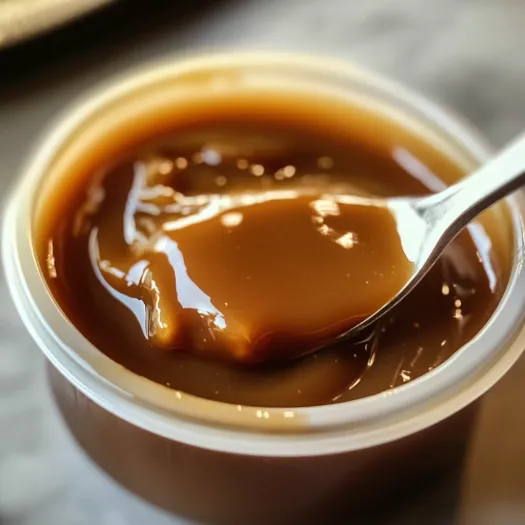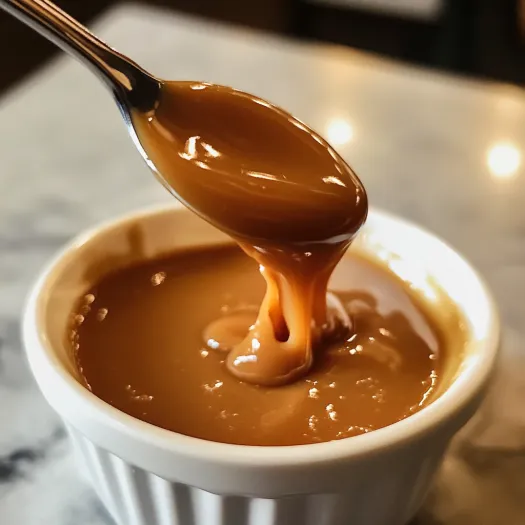 Pin
Pin
This rich, velvety butterscotch sauce transforms ordinary desserts into extraordinary treats. The combination of brown sugar and butter creates that distinctive butterscotch flavor that's both nostalgic and irresistibly delicious. With just a few pantry staples, you'll have a homemade sauce that puts store-bought versions to shame.
I first made this sauce for a family ice cream night and it's now requested at every gathering. My niece even called it "liquid gold" and I've been making double batches ever since!
Ingredients
- Unsalted butter: Creates the rich base and allows you to control the salt level
- Brown sugar: Provides that classic caramel like flavor with deeper notes than white sugar
- Heavy cream: Gives the sauce its luxurious silky texture that coats a spoon perfectly
- Vanilla extract: Adds complexity and warmth to balance the sweetness
- Salt: Enhances all the flavors and creates that perfect sweet salty balance
Step-by-Step Instructions
- Melt the Butter:
- Start with a medium heavy bottomed saucepan over medium heat. Let the butter melt completely until it starts to foam slightly but watch closely to prevent browning. This should take about 2 minutes. A good quality butter makes a noticeable difference in flavor.
- Add Sugar and Cream:
- Pour in the brown sugar and heavy cream, stirring immediately to combine. Use a whisk to ensure there are no sugar lumps. The mixture will look separated at first but keep stirring. Make sure to scrape the sides and bottom of the pan to prevent burning.
- Cook and Thicken:
- Bring the mixture to a gentle rolling boil while stirring constantly. Once boiling, reduce the heat to medium low and let it simmer for 5 to 7 minutes. Stir frequently with a wooden spoon or heat resistant spatula. The sauce should coat the back of a spoon and leave a clear path when you run your finger through it when it's ready.
- Add Vanilla and Salt:
- Remove the pan from heat completely before adding the vanilla to prevent it from evaporating too quickly. Stir in the salt gradually, tasting as you go until you reach your preferred level of saltiness. The sauce will continue to thicken as it cools.
 Pin
Pin
The dark brown sugar is my secret weapon in this recipe. While light brown works perfectly well, the molasses content in dark brown creates a deeper, more complex flavor that reminds me of the butterscotch candies my grandmother always kept in her purse.
The Science Behind Thickening
Understanding why your butterscotch sauce thickens helps achieve the perfect consistency. As the mixture simmers, water evaporates and sugar concentrates, creating that silky texture. If your sauce seems thin, remember it will continue to thicken as it cools. For immediate use, a slightly thinner sauce actually pours better over cold desserts like ice cream.
Troubleshooting Common Issues
If your sauce develops sugar crystals or becomes grainy, you may have stirred too vigorously after adding the sugar. Next time, gently swirl the pan instead of stirring until the sugar completely dissolves. Adding a tablespoon of corn syrup can also help prevent crystallization. If your sauce separates, whisk vigorously off heat or blend with an immersion blender to re-emulsify.
Creative Flavor Variations
The basic butterscotch recipe is a canvas for customization. Try adding a pinch of cinnamon or cardamom for warmth, a tablespoon of maple syrup for a different sweetness profile, or even a teaspoon of instant espresso powder for a mocha butterscotch. My personal favorite is adding a splash of bourbon and a sprinkle of flaky sea salt right before serving for an adult dessert topping.
 Pin
Pin
Frequently Asked Questions About the Recipe
- → How long does homemade butterscotch sauce last?
This butterscotch sauce will last up to 2 weeks when stored in an airtight container in the refrigerator. Always use a clean utensil when serving to extend freshness.
- → Can I use salted butter instead of unsalted?
Yes, you can use salted butter! If doing so, reduce the added salt in the recipe to about 1/4 teaspoon and adjust to taste after cooking.
- → How do I reheat butterscotch sauce?
Gently reheat the sauce in the microwave in 15-20 second intervals, stirring between each interval. Alternatively, warm it on the stovetop over low heat, stirring constantly until it reaches your desired temperature.
- → Why did my butterscotch sauce crystallize?
Crystallization typically happens when sugar molecules reconnect. To prevent this, avoid stirring too vigorously, make sure all sugar dissolves completely, and consider adding a teaspoon of corn syrup to the mixture which helps prevent crystal formation.
- → Can I make butterscotch sauce without heavy cream?
While heavy cream provides the best texture and richness, you can substitute half-and-half or evaporated milk in a pinch. The sauce may be slightly thinner and less rich but will still be delicious.
- → What's the difference between butterscotch and caramel sauce?
Butterscotch sauce is made with brown sugar, which contains molasses, giving it a distinctive flavor. Caramel sauce is made by caramelizing white sugar. Butterscotch has a deeper, more complex flavor with notes of molasses and butter.
